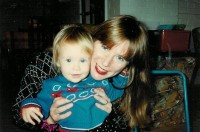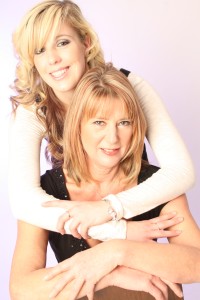Conceived after undergoing fertility treatment
The notes below have been taken from my case files, and the accompanying images have been included with permission from my clients.
Lucy, a children’s author and TV writer, was one of the second wave of women who underwent fertility treatment in the eighties, after the successful birth of the first “test tube baby”, Louise Brown. Fertility treatment was still in the early pioneering stages, so Lucy and her fellow patients were a group of women taking part in a ‘guinea pig ‘ process of collecting data and helping with further research whilst undergoing treatment. Among the things that the volunteers were asked to do was to provide data on their changing hormone levels due to the fertility drugs they were given, at the time. She says: 
“We had to do urine samples every two to three hours round the clock to provide information on our fluctuating hormone levels. Until our date for egg collection had been decided, we would have to troop down to the sample room at regular intervals, and through the night – at 11 p.m., 3 a.m. and 7 a.m.- which wasn’t great for restful sleep! It wasn’t easy as we wanted to drink tea and coffee all day to relieve the monotony, but we were limited to the amount of liquid we could drink during a 24 hour period, in order to produce the correct concentration of chemicals. However, this strange cloistered regime was alleviated by the fact that we were fed royally and developed some fantastic friendships in such a close-knit situation. There was a tremendous camaraderie amongst patients and staff, and a sense of humour was essential! The doctors and nurses were very supportive and caring and the atmosphere at Bourn Hall clinic was of a community all pulling together in a common cause. Although it was always stressful going through treatment, Patrick Steptoe cared about his patients and their welfare and took great pains to make us as comfortable as possible. It turned out to be the most spiritual and rewarding experience of my life. I succeeded twice in getting pregnant over 4 years, so it was a happy outcome. We have been back to visit many times for reunion parties and our daughter (now 18) still feels Bourn Hall is her spiritual birthplace.”
Lucy’s experiences also provided me with the inspiration that led to the research proposal for my thesis: Applications of astrology to health psychology: astrological and psychological factors and fertility treatment outcome.
She had delayed having children until she was in her thirties, not knowing that an infection resulting from an IUD contraceptive device that she had used in her twenties had damaged her fallopian tubes making it impossible to conceive naturally.
She was 34 years old when she began her course of fertility treatments in December 1984 but at this attempt no eggs were fertilised so there were no embryos to implant. Her second attempt took place in Jan/Feb1986, with the successful implant of three embryos. Unfortunately, she lost one of the embryos very early in the process; the second implanted in one of her fallopian tubes and developed into an ectopic pregnancy resulting in the removal of the tube, and the remaining triplet was miscarried in February 1986. This was the most traumatic of all her treatment experiences and a time of “dashed dreams”. She says:
“The whole time was one of unbearable mental agony for me. I spent 3 weeks in hospital and had 3 operations over 6 weeks. It was like being in some gothic nightmare, constantly on tenterhooks, with an alternating cycle of seesawing hopes and plunging despair. I started off feeling really good about this attempt and when it all went wrong I felt cheated, as the loss could have been prevented. It was not the fault of the treatment, but the fact that I had defective fallopian tubes that scuppered the pregnancy. These should have been removed. After the third triplet was lost, I felt very bitter for ages. I felt I had been robbed of my rightful reward. Eventually, I stopped feeling angry and got past the point of caring. I think I went into a mode of trying reverse psychology on myself and pretending I didn’t care, because whenever a treatment came up, I would plan a holiday after it and I would tell myself that if the treatment was successful I could cancel the holiday but if it wasn’t, I could go away and it would help me to put the experience behind me and to keep going forward more positively. When I finally succeeded with Isabel, I had developed a sort of serenity and acceptance, a philosophical attitude, almost nirvanic. I wonder if the astrological factors prevalent at the time helped me psyche myself into this frame of mind. ”
In the years between 1986 and 1988, she underwent a further six treatments totalling eight in all. Every attempt was unsuccessful until the eighth one on the 28th January 1988 when three thawed embryos from an earlier attempt were implanted. One of them implanted successfully. A pregnancy test on 11th February proved to be positive and her daughter was born in October, that year.
The astrology:
Lucy’s data provided the first case for my exploration of astrology and fertility treatment outcome. When I looked at her eight treatment dates, what stood out most strongly was that three astrological factors that are traditionally associated with having children were active according to ancient astrologic al rules during the time when the successful treatment occurred.
al rules during the time when the successful treatment occurred.
Of the earlier treatments one had a time dependent factor (Venus to the Ascendant) and two had a non-time dependent contact involving only Jupiter. At the time of the successful treatment both Venus and Jupiter were involved in aspects to Lucy’s chart.
The last, and successful, attempt had one factor involving Jupiter and the Ascendant (a time dependent factor) during the time when the embryo was implanted that resulted in the birth of her daughter, although this was just after the implant (six days) and not before or on the actual day. She gave her birth time as 3 p.m. and if this time had been rounded up to the nearest hour (as is sometimes the practice) her birth time may have been inaccurate by up to 15 minutes. For the Jupiter contact to happen in the preceding fourteen days before implant (as per my model) her time of birth would have had to be between 2 48 p.m. and 2 56 p.m. (not at 3 p.m., as given). So, had her time of birth been 2 55 p.m. this contact would have occurred just before the embryo implant in line with my research findings.
